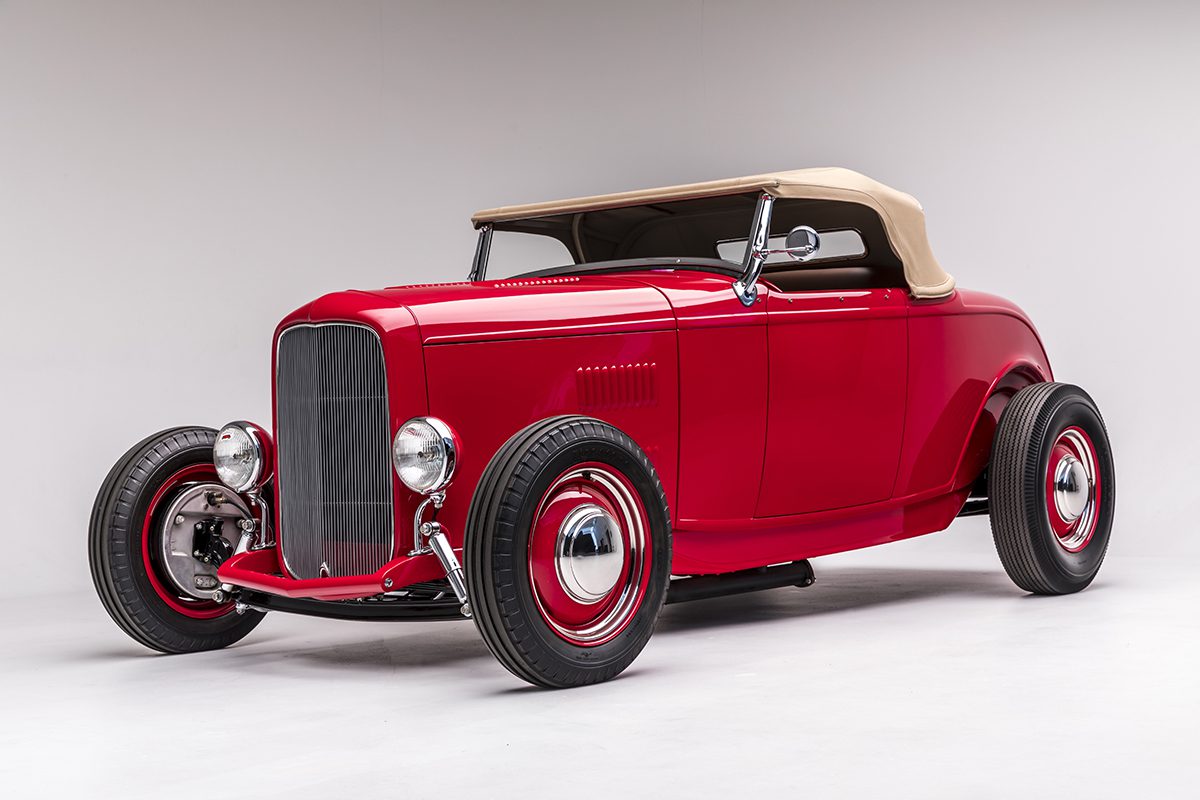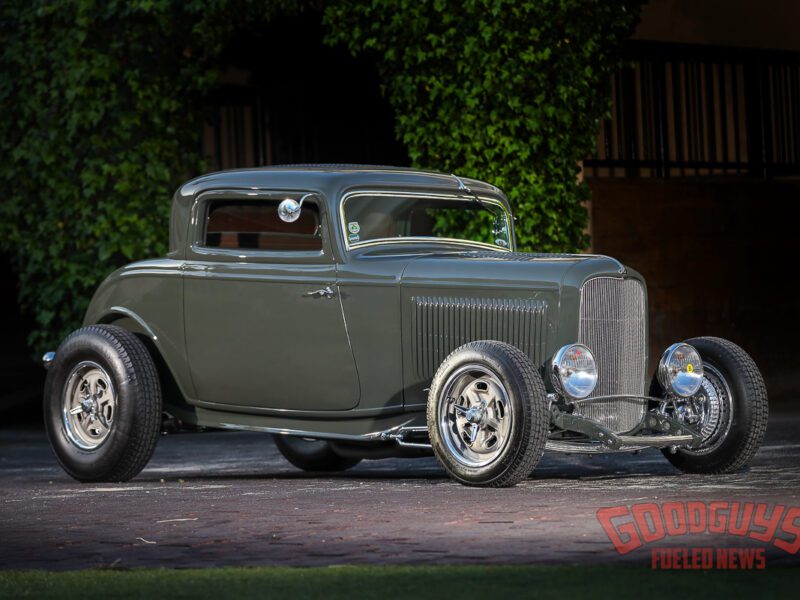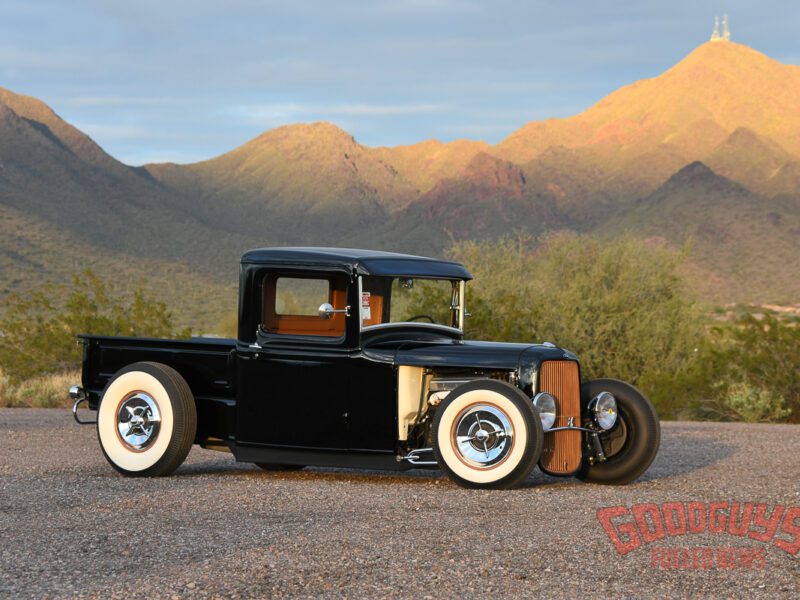The Deuce – Celebrating an American Hot Rod Legend
The Deuce.
It’s hard to fathom a vehicle that has been more influential to the birth, growth, and history of hot rodding as we know it than the ’32 Ford. While it’s true that innovative enthusiasts were modifying cars for improved performance long before Henry Ford’s one-year wonder introduced the Flathead V8 to the world, it’s also obvious that the landscape was forever changed following its introduction.
As we celebrate the 90th anniversary of the ’32 Ford throughout 2022, we wanted to take a deeper look at the car’s history, its legacy, and its legend. Our friends at the Petersen Automotive Museum provided a perfect impetus by declaring a new holiday, Hot Rod Day, on June 11, in conjunction with a new exhibit, “Ford Fever: The Deuce Turns 90.” This exhibit, along with the corresponding Deuce Gala and Deuce Day Cruise-in, were featured just a few weeks back.
Beyond the incredible display and happenings at the Petersen, we also felt it was a perfect opportunity to review some of the influential Deuces from the street rod era, plus standout Goodguys/Meguiar’s Top 12 winners from the past 20 years. You can check out those award winning Deuce’s HERE.
As we celebrate this American hot rod icon, it’s important to know and understand its history. After all, you can’t have a legend without a worthy origin story.
WHY THE ’32?
Probably no other year and make of car has been celebrated quite like the 1932 Ford. It had songs written about it. It co-starred in movies. It’s been a hot rod staple for more than 80 years. Suffice to say, people love the ’32 Ford.
But have you ever wondered why? The ’32 Ford was bookended by some of the most significant and beautiful designs in the car kingdom. Enthusiasts point to various parts of the car for justification, such as its engine, its grille shell, and the exposed frame and tank. They’re dead right, yet there’s so much more to the Deuce than any of its individual parts.
The Deuce has a kind of evergreen popularity: it was heralded when it came out, the following generation practically built the whole hot-rod empire on its shoulders, and another generation downstream used it as a cornerstone for the street rod movement. Rather than losing steam, the ’32 Ford seems to only grow more popular.
To understand the Deuce, you kind of have to understand the relationship among it, the T and A that preceded it, and the Model 40 that followed. The T was Henry’s exercise in incremental improvement; rather than change dramatically, it evolved slowly over its 19-year production run, growing very little and maintaining a scanty 100-inch wheelbase.
The 1920s were opulent, and the cars grew to reflect it. But Ford resisted change at nearly all cost, and it cost him dearly. In 1927, for the first time in the company’s history, it lost the number-one sales position to Chevrolet. And not by a little, either – Chevy beat Ford to the tune of a quarter million cars.
Henry Ford may have loved his Model T, but he really loved that top sales spot. Relenting to his handlers, Ford let them create a car larger, more powerful, and more comfortable – a car so new that he went back to the first letter of the alphabet for its name.
The Model A was bigger, had more power, a selectable transmission, four-wheel brakes, and even shocks. While it was enough to regain Ford the sales mantle in 1929, all of the Model A’s improvements proved to be too little too late. The Model A was still smaller than the competition, which just kept getting bigger. When Chevrolet once again took top sales in 1930, Henry’s handlers returned, pleading for more changes to prevent the company from losing its status.
A V8 FOR THE MASSES
Chevrolet owed a great deal of its success in 1930 to a six-cylinder engine that made 10 more horsepower than the Model A’s four cylinder. Ford wasn’t about to follow. To captivate the buying market, he knew he had to reproduce something that he did with the Model T: He had to give entry-market buyers a kind of unexpected luxury. He did it with something exclusive to high-end cars: a V8 engine.
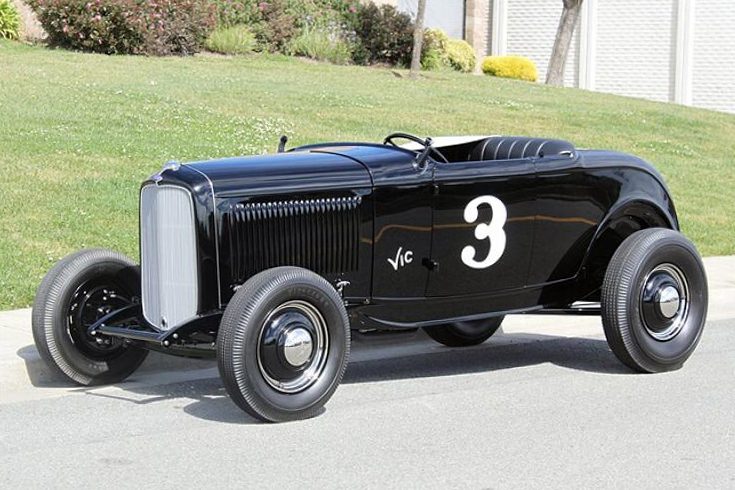
Vic Edelbrock Sr.’s black highboy roadster was a true dual-purpose hot rod in the 1940s, being driven on the street during the week and seeing dry lakes racing duty on weekends as Vic tested new Edelbrock parts.
V-type engines were exclusive to high-end cars because they were expensive to build. The prevailing design for V engines at the time broke the engine block into three parts: two banks of cylinders bolted to a crankcase. The extent of machine work alone made them cost prohibitive. Henry’s solution: cast everything in a single block, something that GM did with its Viking and Oakland lines but with poor success. Casting technology at the time just didn’t exist to successfully cast a V8 block in one piece.
V8 development began in May 1930. The first test example was a 60-degree design and, due to Ford’s famed obstinacy, lacked oil and water pumps. The engine flopped colossally – on the test stand no less. That November they had two 90-degree test mules with pumps, and by February 1931 those engines found their way in Model As, making them the very first A-V8s.
FINE FORM
Meanwhile, Ford’s distressed handlers beckoned Henry for an envelope worthy of the engine. Obviously, it had to be bigger. Also obviously, Henry refused. Chief among his reasons: greater production and operating costs.
To get what they wanted, those handlers appealed to Ford’s sense of parsimony with efficiency – what if they could make it bigger without making it cost significantly more to produce? To do that, they enlisted a whole bunch of technology and design.
To give the car a bigger platform, they stretched the wheelbase to 106.5 inches. To improve its structural integrity, they increased the frame’s cross section. But to counter the greater weight, they brought the chassis to the edge of the body and attached the fenders directly to it, eliminating the fender aprons and their additional weight and cost. To keep the taller car’s profile in check, they made the car ride lower by kicking up the frame over the rear axle. And to maximize rear-seat space they moved the rear spring behind the axle. The fuel tank still doubled as a body component, but they moved it to from the cowl to the back of the car to improve safety and capacity.
Henry’s aesthetically gifted son Edsel brought in Lincoln designer Bob Gregorie to design the new package. A boat designer by training, Gregorie made the car more aerodynamic by rounding key elements like the grille shell and top pillars, reshaping the fenders with gentler curves, and by eliminating the scoop-like windshield visor. Ford’s engineers capitalized on electrical welding processes pioneered by the maker to replace all body structural wood with steel. That made the proposed bodies lighter, stronger, more durable, and easier to produce. By making key components like light housings, hubcaps, grille trim, door handles, and even the gas cap from stainless steel, they could minimize costly plating processes while making the trim more durable.
The car developed slowly – the clay fordor was photographed on October 10, 1931, months after most 1932 vehicles entered full production. And V8 development was even slower. Henry’s other demand – that the exhaust exit the outside of the block rather than the valley as others did it – only complicated issues. Frustrated, Henry opted to shelve the V8 and improve the Model A engine – itself an improvement of the Model T. The new four-cylinder design went into production in November 1931.
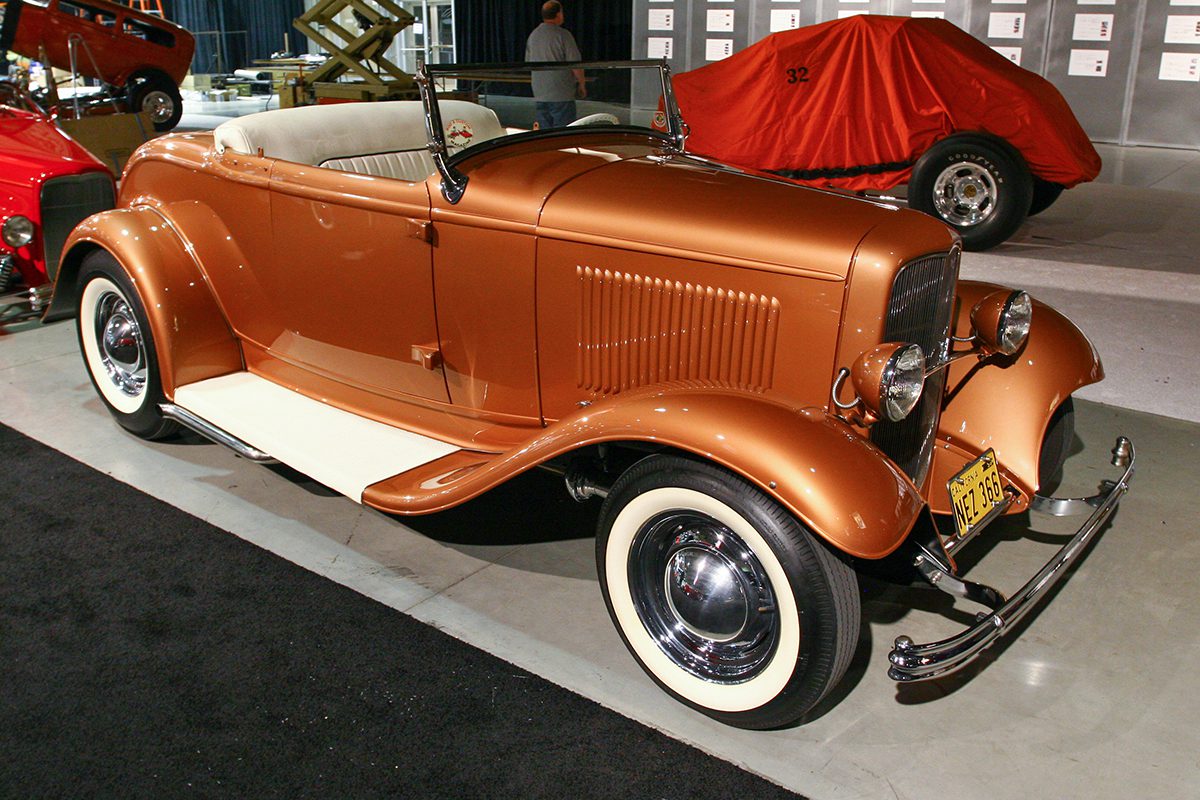
Neal East’s Aztec Gold, full-fendered Deuce represented the early-’60s ideal for street-going roadster’s with a great stance, chrome wheels, whitewalls and white upholstery, plus small-block Chevy power with triple carbs.
But on December 7, 1931, as news developed that the rest of the car wouldn’t be ready for another few months anyway, Ford doubled down on the V8 and ceased four-cylinder production…for the time being. When the 1932 Ford finally hit showroom floors, it was with the V8 and the Model B four-cylinder. And it was April 1932.
With more than half a year’s production lost to downtime, the 1932 Ford had a lot of catching up to do. Understandably, Chevrolet took top spot that year and for the first time ever Plymouth had a chance against Ford. The company lost $75 million as a result of the old man’s resistance to change.
But the battle was finally in Ford’s favor. Though bigger and more comfortable, the V8 standard coupe weighed only 2390 pounds, a mere 120 pounds more than the four-cylinder Model A it replaced and a full 300 pounds less than the timber-laden Chevrolet. And it had 65 horsepower, some 5 more than the heavier Chevrolet. Following the rodder’s axiom, the 1932 Ford had the most powerful engine in the lightest car. Suddenly, luminaries like Wallace Beery, Buster Keaton, and Louis B. Mayer – people who ordinarily would never consider driving anything short of a Packard – bought Fords of their own.
SECONDHAND SUCCESS
We wish we could say that those attributes made V8 Fords fly off the shelves, but they didn’t. Despite critical acclaim, the cars sold relatively poorly. It was later in the secondary market that demand finally grew for the new V8 cars. But by that point, Edsel had finally talked his father into making another car for 1933. While more sophisticated, the Model 40 lacked the diminutive size, light weight, and overall charm of the 1932 Ford.
A decade later, those attributes appealed to GIs returning from World War II to a market devoid of new-car development. As they discovered, the 1932 Ford shed its fenders with only a few bolts. And because of Henry’s insistence of incremental evolution, later and stronger Flathead V8 engines and transmissions bolted right in. Their hydraulic brakes were just about as easy to adapt. This ease of modification, relative light weight, and greater comfort that the slightly bigger package delivered made the ’32 Ford the darling of the postwar hot-rod movement.
From the street to the dry lakes, circle tracks to drag strips, car shows and beyond, the ’32 Ford went on became an icon of hot rodding. Nine decades later, the car’s significance is unquestioned, and its appeal seems timeless. As you’ll see throughout this year, the ’32 Ford has left a commanding legacy.
The Deuce endures.
Photos courtesy the Petersen Automotive Museum, Roy Brizio Street Rods, & Chris Shelton

